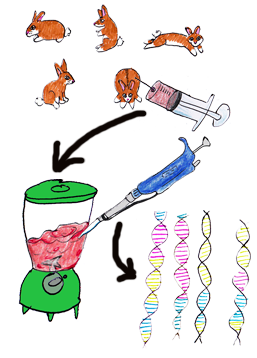You must have heard of it: the gene pool. It’s a popular concept and important in population genetics, wildlife conservation and breeding of domestic animals. The gene pool is a measure of generic diversity.
What is a gene pool?
The gene pool are all the different alleles that are present in a population. For example; you have a population of bunnies of different colors. The colors are caused by different variations of the same gene. All the different variations of the gene make up the gene pool. The gene pool does not bother with frequencies; a variant is either present or not.
You can compare the size of the gene pool between populations or in the course of time. When there are more gene variants present in a population, the gene pool is big. It can get smaller because of stochasticity (e.g. a bottleneck in population size accidentally losing all the individuals with a certain allele), selective breeding or natural selection. It can get bigger because of mutations or introduction of individuals of the same species from a different population.
How to measure the gene pool
 If you want to measure the gene pool, you need to know how many variant of a gene are present in a given population. To do so you need to sample the DNA of a certain amount of individuals in a population. Then you can use DNA sequencing or gel electrophoresis to determine how many variants of the gene are present. You can really only look at one gene or a set of genes at one time. Usually scientists look at genes that are not selected for (neutral genes) or genes that are very important for survival chances of the population (like variation in immune defense genes). The size of the gene pool is a direct measure of the amount of genetic variation.
If you want to measure the gene pool, you need to know how many variant of a gene are present in a given population. To do so you need to sample the DNA of a certain amount of individuals in a population. Then you can use DNA sequencing or gel electrophoresis to determine how many variants of the gene are present. You can really only look at one gene or a set of genes at one time. Usually scientists look at genes that are not selected for (neutral genes) or genes that are very important for survival chances of the population (like variation in immune defense genes). The size of the gene pool is a direct measure of the amount of genetic variation.
What happens if the gene pool gets smaller?
If the gene pool of a population gets smaller you are stating that the amount of genetic variation of a population goes down. In itself this is not bad and it is happening all the time, as natural selection filters out some genetic variation. The problem comes from a too small gene pool. Low genetic variation causes the population to be vulnerable to changes in the environment and stochasticity. When a population has a low variation, there are fewer genes to select on if the environment changes. E.g. if you have a population of only black rabbits they will be more vulnerable to predation when there is snow. A bigger gene pool, with black, white and grey rabbits, gives natural selection a hand hold to select on.






